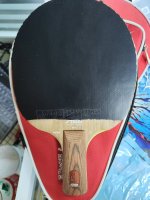This user has no status.
This user has no status.
Well-Known Member
The weight/mass of a tt ball doesn't change. However, the force of impact does as a function of mainly relative impact speed but there are some other factors.
So what is the force of impact if the ball hits the paddle with a relative speed of 10 m/s?
Some assumptions are necessary, state them.
The answer will surprise you.
Many people make a big deal about the flex or vibration of a paddle/blade. How much can a TT ball impact bend a blade. I have a high speed video of a TT ball hitting my toxic 5 and it wobbles visibly a lot but my Firewall+ doesn't seem to notice the impact or the vibrations are so small that it effectively makes no difference.
So what is the force of impact if the ball hits the paddle with a relative speed of 10 m/s?
Some assumptions are necessary, state them.
The answer will surprise you.
Many people make a big deal about the flex or vibration of a paddle/blade. How much can a TT ball impact bend a blade. I have a high speed video of a TT ball hitting my toxic 5 and it wobbles visibly a lot but my Firewall+ doesn't seem to notice the impact or the vibrations are so small that it effectively makes no difference.











